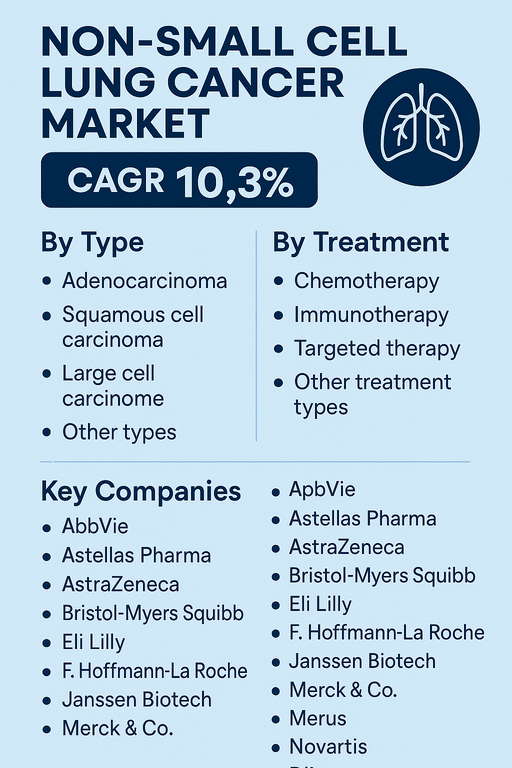The global non-small cell lung cancer (NSCLC) market is projected to expand at a CAGR of 10.3% from 2025 to 2033, driven by the rising prevalence of lung cancer, increasing adoption of targeted and immunotherapy drugs, and growing investment in oncology research. NSCLC accounts for approximately 85% of all lung cancer cases worldwide, making it a critical area of focus in oncology drug development. Advancements in biomarker-driven therapies and the availability of personalized treatment regimens are reshaping clinical practices and expanding treatment options.

Increasing Adoption of Targeted and Immunotherapies
Targeted therapies and immunotherapies are transforming the NSCLC treatment landscape. The use of immune checkpoint inhibitors, such as PD-1/PD-L1 inhibitors, and targeted drugs against EGFR, ALK, and ROS1 mutations have significantly improved patient survival rates. Expanding genetic testing for patients with NSCLC is enabling the adoption of precision medicine, while ongoing clinical trials continue to introduce novel drugs targeting rare mutations. The shift toward combination therapies involving chemotherapy and immunotherapy is also contributing to market growth.
High Cost of Therapies and Access Barriers
Despite the promising outlook, challenges such as the high cost of targeted and immunotherapy treatments and limited access in low- and middle-income regions hinder market penetration. Long treatment durations, adverse side effects, and variability in patient response remain significant barriers. Furthermore, the complexity of drug development and regulatory approval processes adds to the challenges faced by pharmaceutical companies. Nonetheless, increasing government healthcare spending, broader insurance coverage, and ongoing R&D collaborations are expected to ease these constraints.
Market Segmentation by Type
The market is segmented into adenocarcinoma, squamous cell carcinoma, large cell carcinoma, and other types. In 2024, adenocarcinoma accounted for the largest share due to its high prevalence, particularly among non-smokers. Squamous cell carcinoma remains a significant segment, especially in smokers, while large cell carcinoma and other types are less common but require specialized treatment approaches.
Market Segmentation by Treatment
By treatment, the market is divided into chemotherapy, immunotherapy, targeted therapy, and other treatment types. In 2024, immunotherapy dominated the market, driven by approvals of immune checkpoint inhibitors and growing adoption in first-line therapy. Targeted therapy is expanding rapidly with the identification of new biomarkers and rising use of next-generation sequencing. Chemotherapy continues to play a role, particularly in combination regimens, while other treatments include palliative care and supportive interventions.
Regional Insights
In 2024, North America led the NSCLC market, with the U.S. at the forefront due to strong healthcare infrastructure, widespread adoption of biomarker testing, and high access to advanced therapies. Europe followed, supported by robust oncology pipelines and national cancer care strategies in countries like Germany, France, and the UK. Asia Pacific is the fastest-growing region, driven by rising lung cancer prevalence in China, Japan, and India, combined with improving access to innovative drugs. Latin America and Middle East & Africa represent emerging markets where government initiatives and partnerships with pharmaceutical companies are expanding access to oncology treatments.
Competitive Landscape
The 2024 market was dominated by global pharmaceutical leaders investing heavily in oncology R&D. F. Hoffmann-La Roche, AstraZeneca, Merck & Co., Bristol-Myers Squibb, and Novartis led the market with extensive portfolios in targeted therapy and immuno-oncology. Pfizer, Eli Lilly, and Janssen Biotech maintained significant presence in chemotherapy and targeted treatment options. Sanofi, Takeda, and AbbVie expanded their pipelines through collaborations and acquisitions. Astellas Pharma, Merus, Sun Pharmaceutical, and Xcovery contributed with specialized or regionally focused oncology solutions. Competitive differentiation is shaped by drug efficacy, safety, biomarker targeting, pipeline innovation, and global distribution reach.
Historical & Forecast Period
This study report represents analysis of each segment from 2023 to 2033 considering 2024 as the base year. Compounded Annual Growth Rate (CAGR) for each of the respective segments estimated for the forecast period of 2025 to 2033.
The current report comprises of quantitative market estimations for each micro market for every geographical region and qualitative market analysis such as micro and macro environment analysis, market trends, competitive intelligence, segment analysis, porters five force model, top winning strategies, top investment markets, emerging trends and technological analysis, case studies, strategic conclusions and recommendations and other key market insights.
Research Methodology
The complete research study was conducted in three phases, namely: secondary research, primary research, and expert panel review. key data point that enables the estimation of Non-Small Cell Lung Cancer market are as follows:
Market forecast was performed through proprietary software that analyzes various qualitative and quantitative factors. Growth rate and CAGR were estimated through intensive secondary and primary research. Data triangulation across various data points provides accuracy across various analyzed market segments in the report. Application of both top down and bottom-up approach for validation of market estimation assures logical, methodical and mathematical consistency of the quantitative data.
| ATTRIBUTE | DETAILS |
|---|---|
| Research Period | 2023-2033 |
| Base Year | 2024 |
| Forecast Period | 2025-2033 |
| Historical Year | 2023 |
| Unit | USD Million |
| Segmentation | |
Type
| |
Treatment
| |
Gender
| |
End Use
| |
|
Region Segment (2023-2033; US$ Million)
|
Key questions answered in this report